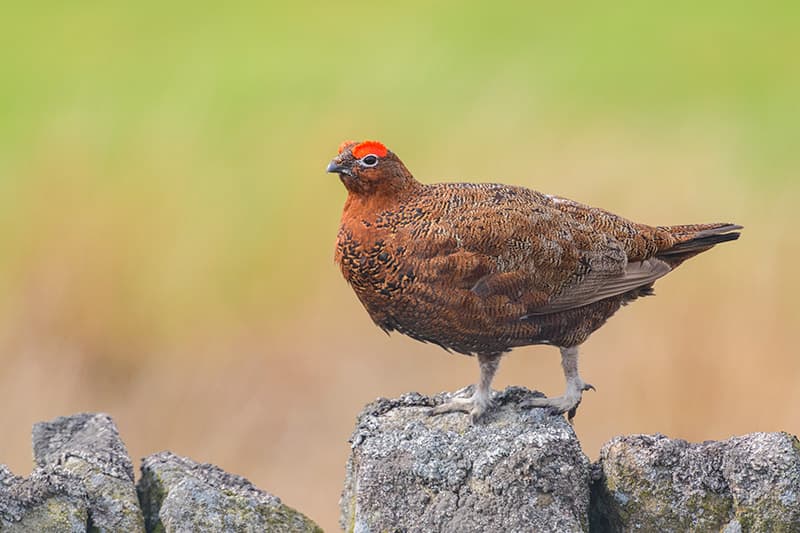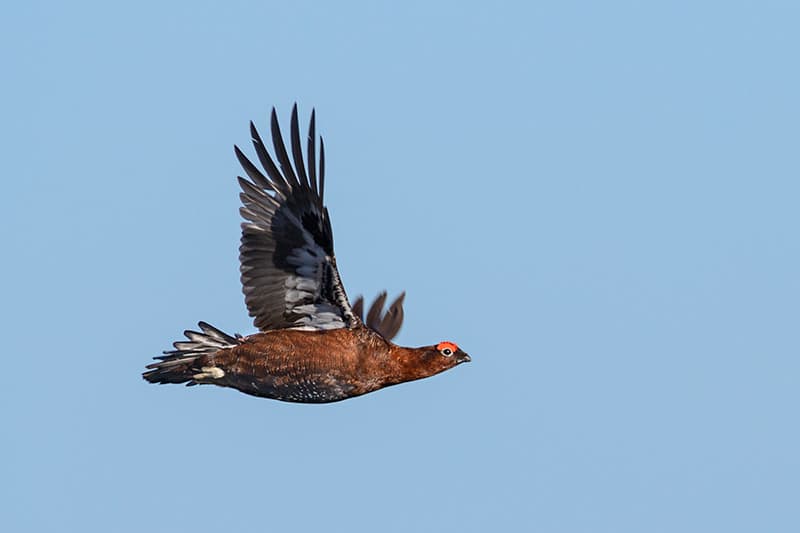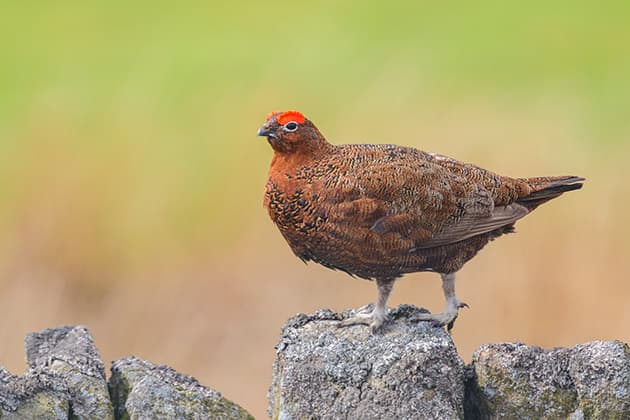
Males will be looking for mates at this time of year and will be more approachable. Nikon D850, 800mm, 1/1000sec at f/6.3, ISO 640. Credit: Oscar Dewhurst
About the red grouse
The red grouse is confined to upland heather moors. They rely on the heather for foraging, shelter and breeding. The call of a male is a characteristic sound of their moorland habitat.
- Location Typically found in northern England, Scotland and Wales, and some parts of Northern Ireland.
- Size Length 37-42cm; wingspan 55-66cm.
- Nest Eggs are laid in a shallow scrape on the ground, up to 20cm across, which is lined with vegetation.
- Diet Feeds primarily on heather, eating the shoots, seeds and flowers.
- UK population 230,000 breeding pairs.
Endemic to the UK, the red grouse is an attractive, medium-sized game bird. They are a subspecies of the willow grouse, which are found across northern Europe, Asia and North America, but unlike willow grouse, red grouse do not turn white in winter. Since the mid-1800s, the habitats of the red grouse have been extensively managed to control populations for shooting. Rotational heather-burning techniques are used to promote fresh growth, which is highly nutritious for the grouse. Burning in patches leaves some taller, older heather, which provides cover for the birds. However, there is much controversy over the management of upland heather moors in this way, as some studies have suggested burning heather has several negative effects. In addition, the illegal persecution of birds of prey such as hen harriers on grouse moors has significant detrimental effects on hen harrier populations.
The dependence of red grouse on heather for shelter, foraging and nesting means they can be found there all year round. At this time of the year, males will be displaying in the hope of attracting mates, so are more approachable. Get out early or late in the day as birds tend to be more active around these times. Also, the sun will be lower in the sky, and its light has a much softer quality. When the sun is near the horizon, you can also experiment with backlighting and side-lighting. This can be very effective in the right scenario, and will mean your images stand out from those of others.

Get out early or late in the day when the light is much softer. Nikon D850, 800mm, 1/1600sec at f/8, ISO 500. Credit: Oscar Dewhurst
Shooting advice
The red grouse can be very timid, which is unsurprising given the relationship between the birds and some humans. Often, the first time you become aware of one is as it explodes out of the heather and disappears into the distance, making a ‘goback’ call as it goes. Despite this, some individuals can be very confiding, particularly during the spring when males are displaying. When photographing at this time of the year, I would strongly recommend you stick to the paths, as their nests can be extremely well-camouflaged on the ground and the last thing you want is to inadvertently step on one.
Shoot from the same level as your subject for more intimate portraits. This will also throw the foreground and background out of focus, to make them stand out. The red grouse is a great subject all year round. Winter in the uplands often brings snow, which provides a blank canvas and in August and September the heather will flower, creating a carpet of purple. But bear in mind the birds may be more skittish around the shooting season, which starts on 12 August. In the latter part of the year, visit areas where the birds are not actively shot. Otherwise, if they become comfortable in the presence of humans, it may be detrimental to their chances of survival.

Experiment with the light when the sun is close to the horizon. Nikon D850, 400mm, 1/800sec at f/2.8, ISO 1000. Credit: Oscar Dewhurst
Kit list
- Teleconverters Grouse can be skittish, and as you are restricted where you can go by where the paths are, teleconverters are a great way of extending the reach of your equipment. Before you buy any, however, make sure your lenses are compatible, and check out reviews online of the impact on autofocus speed and sharpness.
- Binoculars If I’m photographing wildlife, I never leave home without my binoculars. They are much lighter and clearer to look through than a camera, so make finding the wildlife so much easier, particularly when your subject is as well camouflaged as grouse can be! They’re also great for when you want to put the camera down and just watch.








